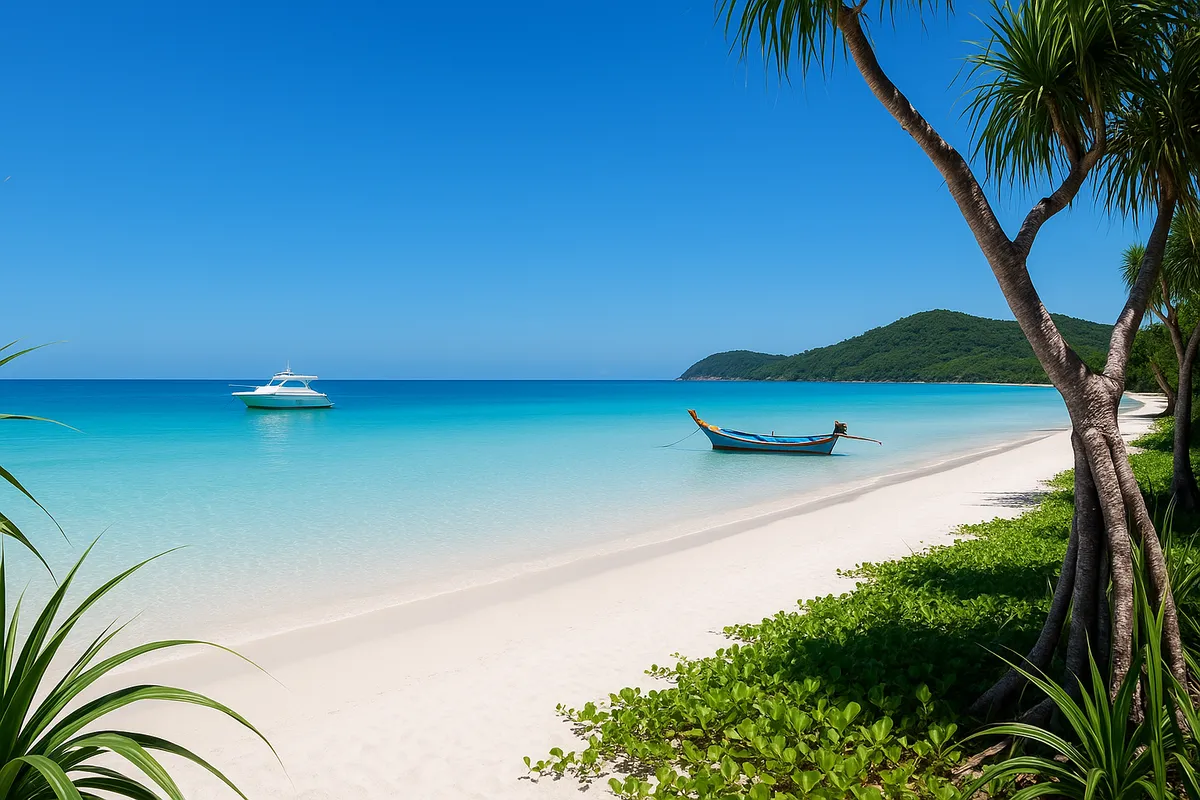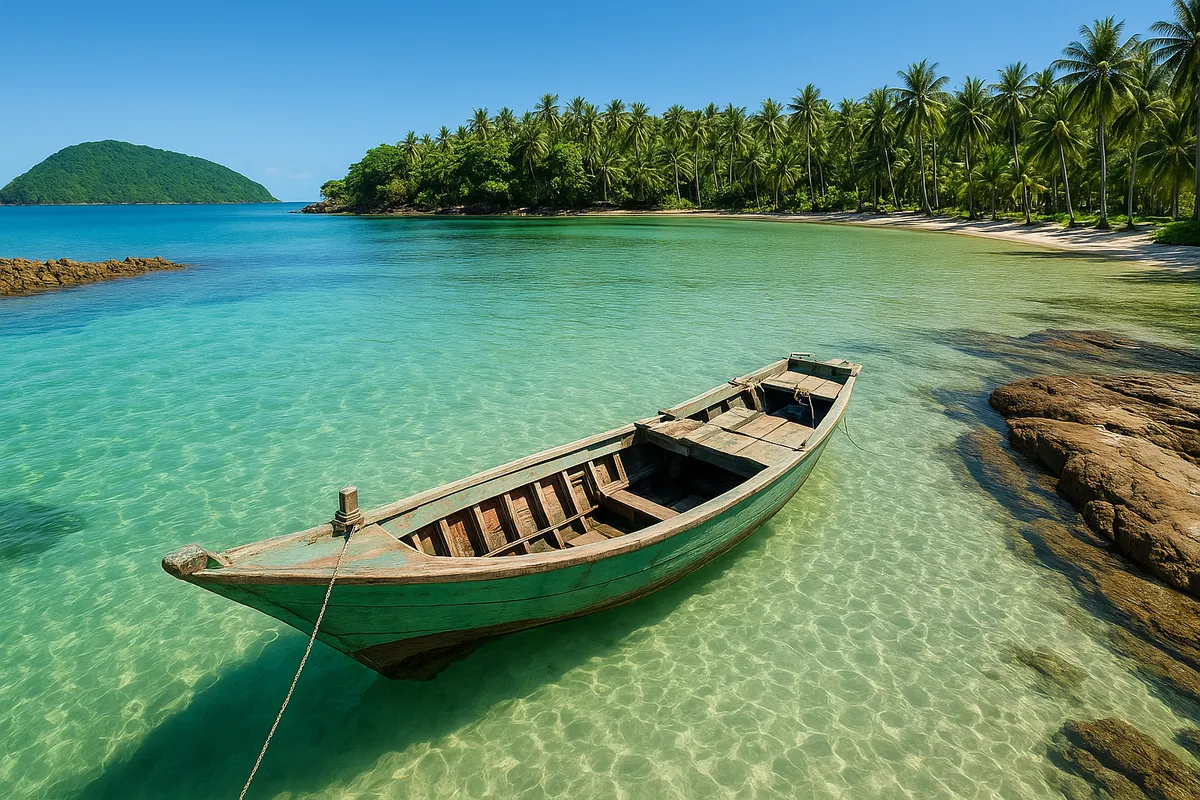Quan Lan Island, a green dream in the heart of Bai Tu Long Bay
- Tuesday, May 06, 2025, 21:23 (GMT+7)
Quan Lan Island, a green dream in the heart of Bai Tu Long Bay
Quan Lan Island rests peacefully like a drifting leaf in the heart of Bai Tu Long Bay, where the waves make no noise, the wind carries no rush, and time itself seems to move slower. Setting foot on this land feels like being lifted out of daily life and placed into a gentle painting crafted by the hands of nature.
Mornings on the island do not begin with the sound of honking cars or hurried footsteps, but with the soft rhythm of waves brushing against the shore, mingled with the cheerful chirping of birds echoing from ancient canarium forests. The first rays of sunlight shimmer on the sea, sketching delicate silk-like sparkles. The breeze of Quan Lan carries a mild salty scent, mixed faintly with the aroma of moss and leaves. Every breath here is soaked in the essence of the sea.
The landscape of Quan Lan plays a quiet symphony between white sand, clear water, and primeval forest. Beaches like Minh Chau, Son Hao, and Quan Lan stretch endlessly without a trace of litter, without bustling shops, only powdery sand that feels like walking on mist. Some call Minh Chau Beach “the breathing beach” because at sunset, the sand turns warm like skin while the water remains cool and crystal clear. On days when the tide recedes, you can walk hundreds of meters out to sea and the water still will not reach your knees, as if the ocean here is unusually gentle and kind.
But Quan Lan is more than just natural beauty. On this modest island stands an ancient communal house nearly five hundred years old, where locals honor the brilliant general Tran Khanh Du. The structure is built entirely of ironwood and golden oak, intricately carved with winding dragons and clouds, its mossy tiled roof and aged floor bricks quietly holding the footprints of generations past. Locals say that in the thirteenth century, it was right in these waters that the general led a victorious ambush against the Yuan army’s food fleet, contributing to the triumphant battle on the Bach Dang River. History here does not sit inside textbooks, but lives in faded calligraphy scrolls and in the echo of ceremonial drums that resonate from the temple during village festivals.
Each year in mid lunar June, when the sea is calm, villagers hold a traditional boat rowing festival to commemorate that historic victory. It is a vibrant day filled with colors, not from speakers or modern stages, but from spirited cheers and the splash of oars beating the water in rhythm with ancient drums. This is not a tourist show, but a sacred community ritual full of pride and reverence. “One stroke of the oar, a hundred years remembered,” they often say.
Few may know that hidden within Quan Lan is an ancient ceramic trade route, where merchant ships from China and Japan once stopped before sailing to Thang Long. Fragments of ceramics from the fourteenth century have been unearthed under coastal soil, bearing witness to a once bustling port during the Ly and Tran dynasties. Back then, Quan Lan was not just a fishing island but a gateway for maritime commerce, where the silhouettes of sailboats against twilight resembled brush strokes on a water ink painting.
The primeval canarium forest on the island is a natural treasure. The trees grow in rows, tall and upright, casting a gentle shade like a green dome overhead. As wind rustles through the leaves, it creates a quiet music like an ancient fairy tale. On sweltering summer days, just standing under this canopy can make the soul feel refreshed.
Getting to Quan Lan is not a hurried journey. From Hanoi, the road winds toward Cai Rong, then a speedboat ride of nearly an hour brings you across the waves to a peaceful dot in the vast ocean. Not as hurried as Co To, nor as familiar as Ha Long, Quan Lan carries a quiet charm, like an old soul who speaks little but holds deep stories. The trip becomes a journey of reflection, of slowing down to truly feel each shade of nature.
The most ideal time to visit is from April to August, when the sea is calm, the sky is high, and the sunlight glows like golden honey. During mid summer, the island welcomes abundant sunshine without the stifling heat, thanks to the sea breeze that always blows cool like a mother’s fan on a childhood afternoon.
On the island, transport is mainly by electric car, tuk tuk, or rental motorbike. Slowly circling the island, passing rows of casuarina trees and mossy rooftops, one may spot children flying kites on open fields or elderly women in conical hats picking vegetables by the roadside. Quan Lan has no malls, no noisy bars, only small morning markets where even the vendors’ calls are as gentle as the sea wind.
The cuisine here is something people remember long after they leave. A dinner on the sand by a crackling fire, the sound of charcoal popping, and the scent of grilled oysters in the air is a luxury only Quan Lan can offer. Tamarind crab, grilled peanut worm, steamed geoduck with ginger, and congee with blood cockles are memory-worthy flavors that linger. An interesting truth is that Quan Lan’s peanut worm was once considered a royal delicacy, valued for its nutrition and rarity. Today, locals harvest this seafood during low tide season, when the beams of hand torches twinkle like fireflies on the night sand.
Some say traveling to Quan Lan is a way to rediscover the most original version of the Vietnamese sea, where no artificial lights dull the moon and no industrial sound overshadows the song of the waves. The sea here does not flaunt or seduce, it simply stays quiet and gently embraces every footprint.
Standing on Minh Chau beach at dusk, watching the sun sink like a ripe orange dropped into a glass of clear ice water, one finally understands why this place is called a green dream. In that moment, a thought arises, one that could spark any wanderer’s heart: “There are places that need no reason to visit, just one weary day is enough to long for them.”
Quan Lan Island may not suit those in a rush. But it is the perfect place for souls longing to pause, to breathe deeply, and let the heart be free alongside nature, history, and all the quiet beauty forgotten in the spin of urban life.
Perhaps everyone needs to visit Quan Lan once, to know that on the map of Vietnam, there are still havens this serene, and to let the heart feel the slow, real rhythm of earth and sky.

 CHECKIN.VN
CHECKIN.VN








Share on